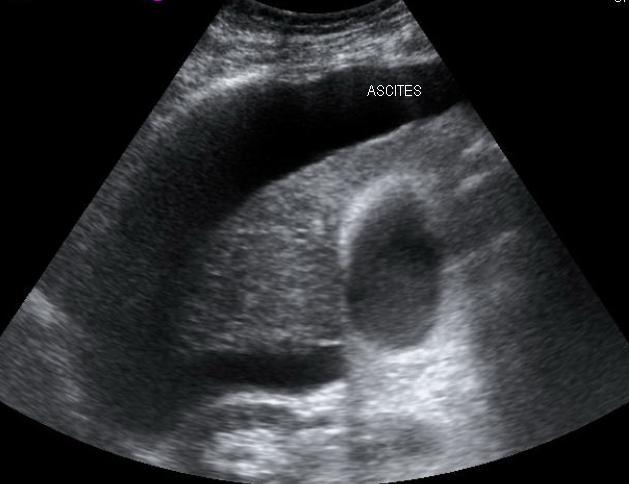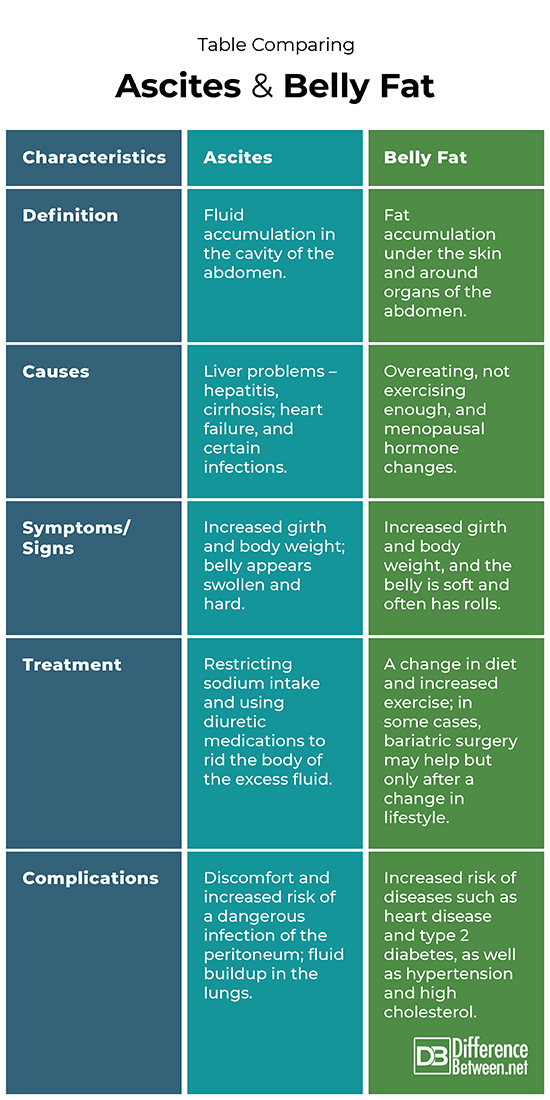Difference Between Ascites and Belly Fat
Ascites is the condition in which there is too much fluid occurring and collecting in the abdominal cavity. Belly fat is adipose tissue that is deposited around organs and under the skin in the abdominal region.

What is Ascites?
Definition of Ascites:
Ascites is defined as fluid accumulation in the abdominal cavity of the body.
Causes:
There are many reasons for ascites to develop including liver problems such as hepatitis, and also cirrhosis leading to portal hypertension, as well as non-liver problems. Heart failure, kidney disease, and infections of the peritoneum; sometimes ascites occurs as a complication of surgery.
Symptoms and diagnosis of Ascites:
There isn’t usually any pain and as fluid accumulates the width of the abdomen increases and the person gains weight. In extreme cases the abdominal wall will become tight, and the person may become short of breath and feel nauseated. A doctor can diagnose ascites by examination and noting the presence of a fluid wave and a dullness that shifts while the doctor percusses the abdomen from side to side. A CT scan and ultrasound can also be used to detect free fluid accumulation. Sampling fluid from the abdomen can often indicate the cause, whether from infection or portal hypertension.
Ascites Treatment:
Treatment includes restricting sodium intake and using diuretic medications such as some combination of spironolactone and furosemide.
Complications:
Ascites can result in much discomfort and an increased risk of a dangerous infection of the peritoneum. In extreme cases, there may even be a fluid buildup in the lungs.

What is Belly Fat?
Definition:
Belly fat is adipose tissue that accumulates in and around organs of the abdomen and under the skin.
Causes:
The accumulation of belly fat often happens when people take in too many calories during the day compared to what calories are being used up. The condition is also common in menopausal women where hormone changes make accumulation of fat more likely, with women having more abdominal fat after menopause than before menopause.
Symptoms and diagnosis:
The sign of belly fat is weight gain and expanded girth of the abdomen, which can be visually noticed. The person also often has a high BMI indicating they are overweight or obese for their height. The only accurate way to measure the amount of visceral belly fat is by an imaging test, but skinfold calipers can be used to show how much fat is under the skin on the belly.
Treatment:
A change in diet and increased exercise may help the person lose fat. Very obese individuals may opt for bariatric surgery but there are significant risks to such procedures, and usually a change in lifestyle with some weight loss is needed before surgery can even be considered.
Belly fat Complications:
Belly fat is dangerous because it increases the risk of diseases such as type 2 diabetes and heart disease.
Difference between Ascites and Belly fat
Definition
Ascites is fluid accumulation in the cavity of the abdomen. Belly fat is accumulation of fat under the skin and around organs of the abdomen.
Causes
Ascites is often caused by problems with the liver, including hepatitis and cirrhosis, but also happens from heart failure and certain infections. Overeating, not exercising enough, and menopausal hormone changes are causes of belly fat.
Symptoms/Signs
Increased girth and body weight and a belly that appears swollen and hard are symptoms of ascites. Increased girth and body weight and a belly that appears soft with rolls, are signs of belly fat.
Treatment
Treatment for ascites includes restricting sodium intake and using diuretic medications to rid the body of the excess fluid. Treatment for belly fat includes a change in a diet and increased exercise; bariatric surgery may help in certain situations but only after a change in lifestyle.
Complications
Complications of ascites include discomfort and increased risk of infection. Complications of belly fat include increased risk of diseases such as type 2 diabetes and heart disease.
Table comparing Ascites and Belly fat

Summary of Ascites Vs. Belly fat
- Ascites and belly fat are both conditions associated with the abdominal part of the body.
- Ascites is specifically as a result of a disease state, while belly fat is due to gaining body fat and weight.
- Ascites requires medical treatment such as the use of diuretics.
- Belly fat can often be prevented and reduced by a change in diet and exercise.
FAQ
Is ascites stomach hard or soft?
Ascites stomach is hard and not soft, and the belly protrudes.
How can you tell if you have ascites?
One possible clue is that your belly swells up suddenly. However, the only way to tell for certain is to see a doctor who can also order tests such as CT scans to further confirm the diagnosis.
What does an ascites belly feel like?
Ascites belly feels hard to the touch.
Is Beer Belly same as ascites?
Beer belly is not the same thing as ascites. The term beer belly refers to fat that has accumulated around the viscera of the abdomen.
Does drinking water help ascites?
No, drinking water does not specifically help ascites and may worsen the problem if the person has not cut back on their salt intake. Consult with your doctor to find out what you should eat and drink if you have ascites.
Does ascites make your abdomen hard?
Yes, ascites makes the abdomen hard and swollen.
- Difference Between Rumination and Regurgitation - June 13, 2024
- Difference Between Pyelectasis and Hydronephrosis - June 4, 2024
- Difference Between Cellulitis and Erysipelas - June 1, 2024
Search DifferenceBetween.net :
Leave a Response
References :
[0]Mayo Clinic. “Belly fat in women: Taking — and keeping — it off.” Mayo Clinic, 2021, https://www.mayoclinic.org/healthy-lifestyle/womens-health/in-depth/belly-fat/art-20045809
[1]Tholey, Danielle. “Ascites.” Merckmanuals. Merck & Co., 2021, https://www.msdmanuals.com/professional/hepatic-and-biliary-disorders/approach-to-the-patient-with-liver-disease/ascites
[2]Toth, Michael J., et al. "Menopause‐related changes in body fat distribution." Annals of the New York Academy of Sciences 904.1 (2000): 502-506.
[3]Image credit: https://commons.wikimedia.org/wiki/File:Ascites_ultrasound_2.JPG
[4]Image credit: https://commons.wikimedia.org/wiki/File:Obese_teenagers_male_overweight_fat_front_belly.jpg
